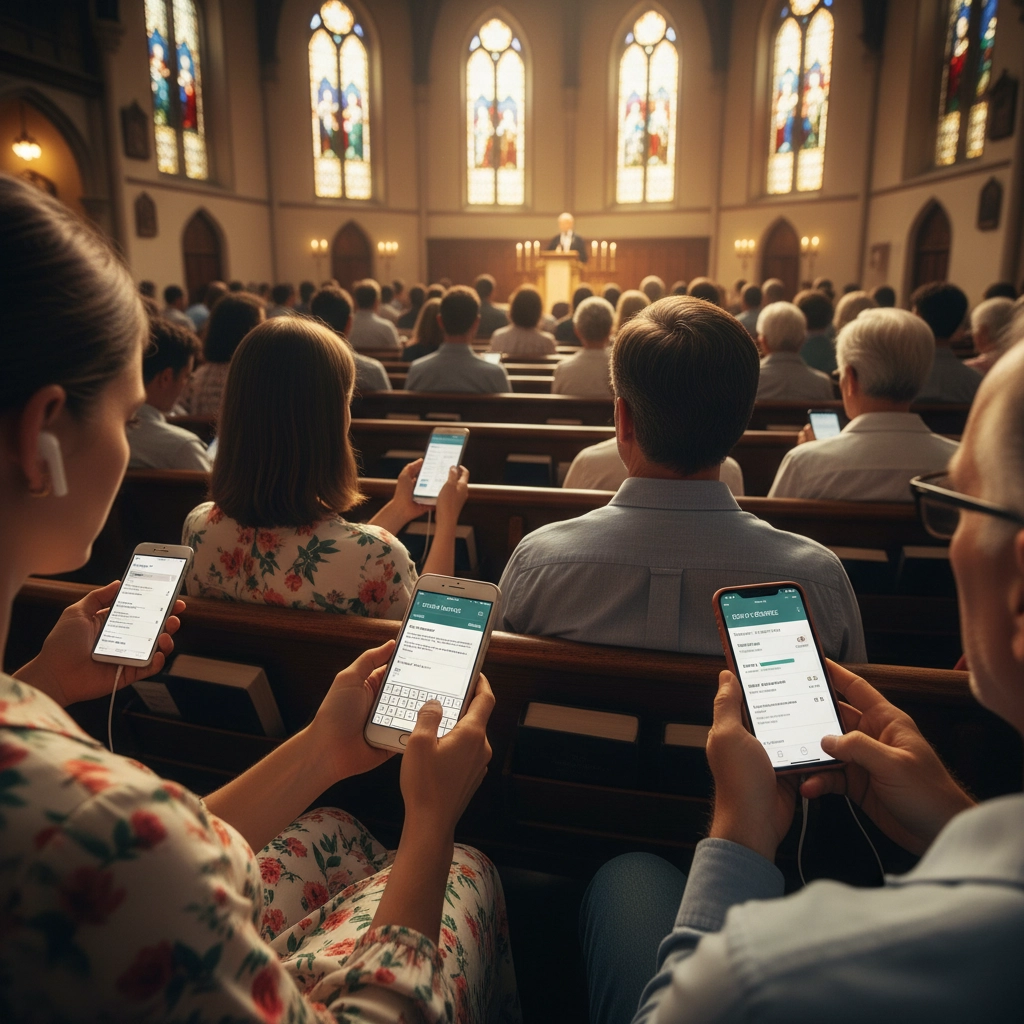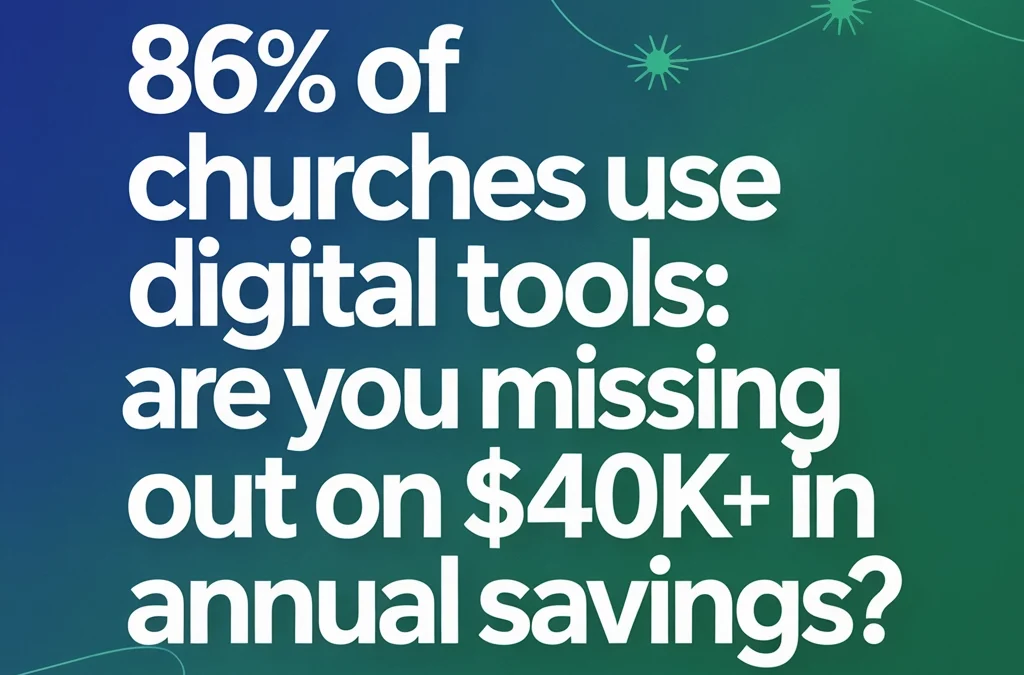Here's a statistic that might surprise you: 86% of churches now use digital tools to manage their ministries. If you're still running your church operations with spreadsheets, paper forms, and manual processes, you're not just behind the curve: you could be missing out on thousands of dollars in annual savings.
The digital transformation in churches isn't just about keeping up with trends. It's about freeing up resources, reducing administrative burden, and getting back to what really matters: ministry. Let's dive into what this means for your church and why making the switch could be one of the best financial decisions you make this year.
The Digital Church Revolution is Here
Church management software (ChMS) adoption has reached an impressive 86% of churches, with a steady 4% year-over-year increase. But it's not just management software: mobile app adoption has grown to 67% of churches, and here's the kicker: 70% of church leaders report that technology has actually increased generosity within their congregation.
This isn't just about being tech-savvy. It's about recognizing that digital tools have moved from nice-to-have conveniences to essential ministry infrastructure. When 86% of church leaders believe digital tools play a vital role in fostering deeper connections within their congregations, you know something significant has shifted.

Where the Real Savings Come From
So where does that potential $40K+ in annual savings come from? It's not one big expense: it's the death by a thousand cuts of inefficient processes that digital tools can eliminate.
Staff Time Liberation
Think about how many hours your staff spends on administrative tasks each week. Managing member databases, processing donations, coordinating volunteers, sending communications, tracking attendance: these tasks can easily consume 15-20 hours per week for a mid-sized church. At an average pastoral salary, that's potentially $15,000-20,000 annually in labor costs that could be redirected to actual ministry work.
Increased Giving Through Digital Platforms
Here's where the numbers get exciting. Churches using digital giving platforms typically see a 15-30% increase in overall donations. For a church with $200,000 in annual giving, that could mean an additional $30,000-60,000 per year. The convenience of mobile giving, recurring donations, and text-to-give options removes friction that often prevents spontaneous generosity.
Reduced Administrative Costs
Paper forms, printing, postage, manual data entry: these costs add up faster than you might think. A typical church can spend $3,000-5,000 annually on printing and mailing alone. Digital communications and online forms can eliminate most of these expenses while actually improving communication effectiveness.
The Communication Game-Changer
Communication remains the top challenge that 51% of ministry leaders hope technology can better address. And for good reason: ineffective communication is expensive. When members miss events, volunteers don't show up, or important information gets lost in the shuffle, it costs your ministry real money and momentum.

Modern church management systems can automate much of this communication:
- Automated welcome sequences for new members
- Event reminders that actually reach people
- Volunteer scheduling that updates in real-time
- Prayer request management that doesn't fall through cracks
The Streaming Success Story
Here's something that might surprise you: 87% of churches continue to stream their worship services, and it's not just about COVID anymore. Churches are discovering that streaming capabilities can significantly expand their reach and, consequently, their giving base.
Churches with quality streaming setups report engaging with 20-40% more people than their physical attendance numbers. That expanded reach translates to expanded giving potential, expanded volunteer recruitment, and expanded ministry impact.
AI is No Longer Science Fiction
The AI adoption surge in churches is remarkable: 45% of church leaders now use AI, representing an 80% increase from just last year. Before you think this sounds too complicated, consider what churches are actually using AI for:
- Automated social media content creation
- Email newsletter writing assistance
- Event planning and scheduling optimization
- Donor communication personalization
- Volunteer matching and coordination
These applications save hours each week while often producing better results than manual efforts.

What Happens When You Don't Adapt?
The statistics paint a clear picture: churches embracing digital tools are gaining significant advantages in member engagement, operational efficiency, and financial performance. Churches that haven't made the transition are increasingly finding themselves at a disadvantage.
Consider this: if 86% of churches are using digital tools effectively, they're attracting members who expect seamless digital experiences. They're operating more efficiently, communicating more effectively, and often growing faster than churches still relying on manual processes.
The financial confidence in church technology is growing too. Concerns about the financial cost of adopting new technology fell 9% this year: the first reported decline since tracking began. Meanwhile, 52% of church leaders increased their technology budgets, showing that the return on investment is becoming clear.
Making the Transition Doesn't Have to Be Overwhelming
If you're feeling behind, don't panic. The key is starting with the basics and building from there. Most successful church technology implementations follow this pattern:
Phase 1: Core Management
Start with a church management system that handles your member database, giving tracking, and basic communications. This alone can save 10+ hours per week in administrative tasks.
Phase 2: Digital Giving
Implement online and mobile giving options. The convenience factor alone typically increases overall donations by 15-25%.
Phase 3: Communication Automation
Set up automated welcome sequences, event reminders, and volunteer communications. This ensures nothing falls through the cracks while reducing staff workload.
Phase 4: Enhanced Engagement
Add mobile apps, advanced streaming capabilities, and AI-powered tools to further streamline operations and expand reach.
The Bottom Line
The 86% adoption rate isn't just a statistic: it's a signal. Churches across the country have discovered that digital tools aren't just about keeping up with technology trends. They're about stewarding resources more effectively, reducing administrative burden, and focusing energy on actual ministry work.
Whether your potential savings reach $40K+ depends on your church size, current inefficiencies, and how strategically you implement digital solutions. But the pattern is clear: churches using these tools are operating more efficiently, engaging more effectively, and often growing faster than those that aren't.
The question isn't whether digital tools will become standard in church operations: they already are. The question is whether your church will join the 86% who are experiencing these benefits, or remain in the shrinking minority still struggling with manual processes and missing out on both savings and ministry opportunities.
Ready to explore how digital tools could transform your church operations? The best time to start was yesterday. The second-best time is today.

